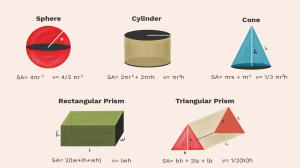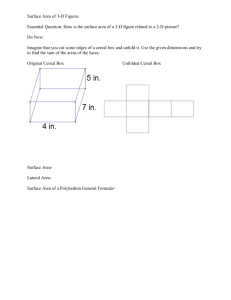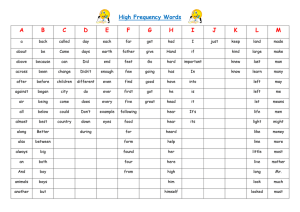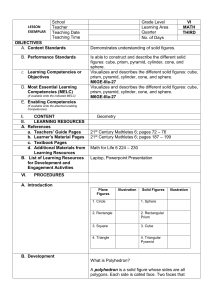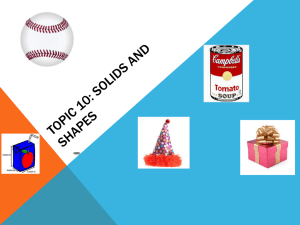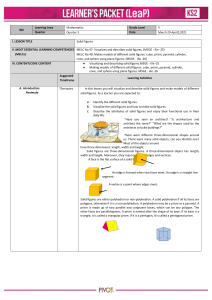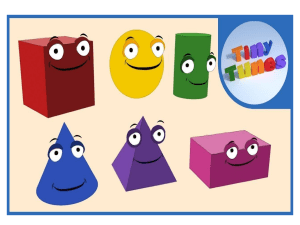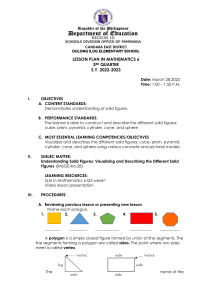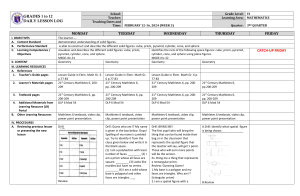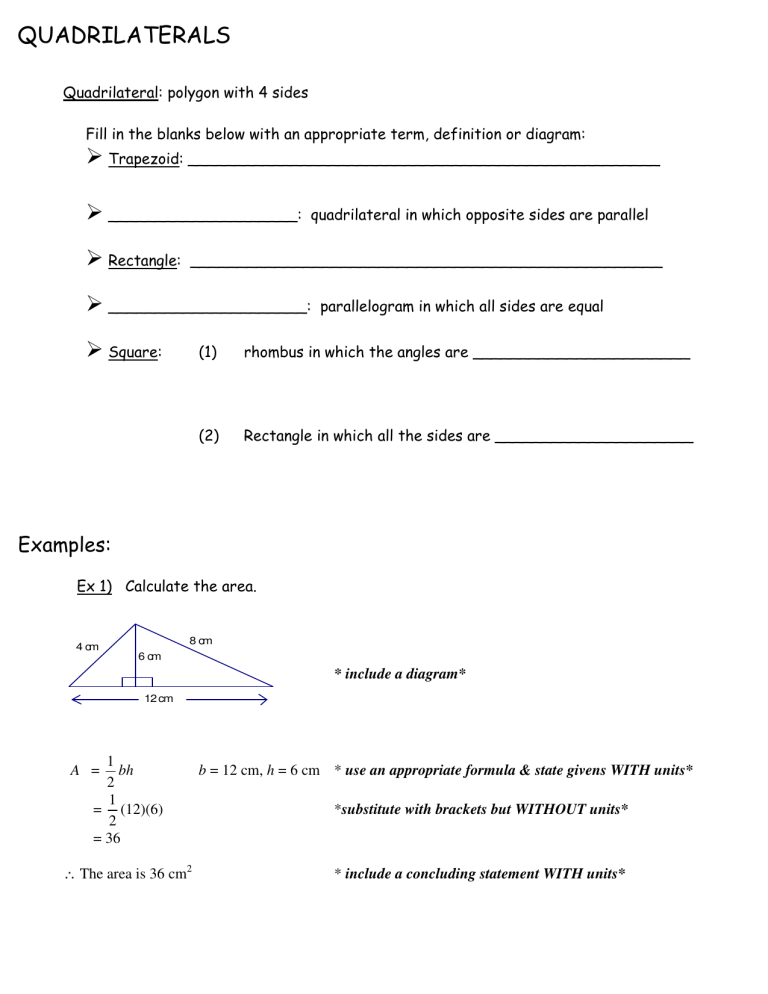
QUADRILATERALS Quadrilateral: polygon with 4 sides Fill in the blanks below with an appropriate term, definition or diagram: Trapezoid: __________________________________________________ ____________________: quadrilateral in which opposite sides are parallel Rectangle: __________________________________________________ _____________________: parallelogram in which all sides are equal Square: (1) rhombus in which the angles are _______________________ (2) Rectangle in which all the sides are _____________________ Examples: Ex 1) Calculate the area. 8 cm 4 cm 6 cm * include a diagram* 12 cm 1 bh 2 1 = (12)(6) 2 = 36 A = ∴ The area is 36 cm2 b = 12 cm, h = 6 cm * use an appropriate formula & state givens WITH units* *substitute with brackets but WITHOUT units* * include a concluding statement WITH units* Ex 2) Find the value of the variable if A = 69 cm². 8 cm h ( a + b) 2 h((15) + (8)) (69) = 2 138 = h (23) 138 =h 23 6=h A = h 15 cm a = 15 cm, b = 8 cm, A = 69 cm2 ∴The height is 6 cm. Ex. 3) Find the area of the shaded region. 14 mm 1 mm A = Asquare – Atriangle 1 = s2 - bh 2 1 = (14)² - (1)(14) 2 = 196 - 7 = 189 s = 14 mm, b = 1 mm, h = 14 mm ∴The area of the shaded region is 189 mm2 Ex 4) Find the perimeter of the following. 8 cm 4 cm 1 π d + d + 2b 2 1 = π (4 ) + (4 ) + 2 (8) 2 = 2π + 20 P= d = 4 cm, b = 8 cm ≈ 26.3 ∴ The perimeter is 26.3 cm HOMEWORK: Grade 9 Textbook: p. 432 # 1abce, 2bcde, 3, 4, 10, 12, 15 (Include diagrams with your answers!) 3-2 3-Dimensional Geometry Terminology Solid: a 3-dimensional figure with a closed surface and a measurable volume Cube Cylinder Polyhedron: A 3-dimensional figure with faces that are polygons There are two types of polyhedrons: Prisms & Pyramids Prism: - polyhedron with two parallel, identical, polygonal faces (bases) - they are distinguished from each other by the shape of their base Triangular Prism Cube ( Square Prism) Rectangular Prism Pentagonal Prism Pyramid: a polyhedron whose base is a polygon and other faces are triangles that meet at a common point Square-based Pyramid Triangular-based Pyramid Hexagonal Pyramid ROUND BODIES Round Body: solid that has at least one curved surface There are three types of round bodies: Cylinders, Cones, & Spheres Cylinder: solid in which the two opposite faces are equal circles and the straight line joining their centres is perpendicular to the base Cone: solid with a circular base and a curved lateral surface that extends from the base to a point called the vertex Sphere: solid in which all the points are the same distance from a fixed, interior point called the centre Examples: Ex. 1) Find the volume of a cylinder if d = 12.6 cm and h = 15.8 cm. V = πr 2 h r = 6.3 cm, h = 15.8 cm = π (6.3) 2 (15.8) ≈ 1969 15.8 cm ∴ The volume is approximately 1969 cm³ 12.6 cm Ex. 2) A silo has a radius of 2.35 m and a height of 10.24 m. Find the area of the exposed surface of the silo to the nearest m². 2.35 m Atotal = A1 + A2 = 2πrh + 2πr 2 (2) 10.24 m (1) r = 2.35 m, h = 7.89 m = 2π (2.35)(7.89) + 2π (2.35) 2 = 48 128π ≈ 151 ∴ The area of the exposed surface is approximately 151 m². *height of the cylinder is: 10.24 – 2.35 = 7.89* HOMEWORK: (Include diagrams with your answers!) Grade 9 Textbook: pg. 441 # 1a, 2a, 3b, 4a, 5, 6, 7, 9 pg. 447 # 1b, 2, 3, 5, 6 pg 454 # 1b, 2a, 4, 5 pg. 459 # 1a, 3, 4, 5 pg 465 # 1a, 3, 4 3-3 Applications Ex. 1) A cone fits just inside a cylinder. The volume of the cylinder is 9 425 cm³. What is the total surface area of the cone to the nearest square centimetre? V = 9425 cm3 Vcylinder = π r 2 h (9 425) = π (10)2 h 9425 = h π (10) 2 30 ≈ h r = 10 cm h2 + r2 = s2 (30)² + (10)² = s2 1000 = s2 ± 31.6 ≈ s h = 30 cm r = 10 cm 20 cm Since s is a side length s > 0 ∴ s ≈ 31.6 A cone = π r 2 + π rs h = 30 cm s = 31.6 cm = π (10) 2 + π (10)(31.6) = 416π ≈ 1307 ∴ The area of the cone is 1307 cm² Ex2) A tennis ball fits just inside a plastic cube whose sides measure 40 mm. Determine the volume of the empty space inside the cube. Vempty space = Vcube − Vball c = 40 mm 4 = c 3 − πr 3 3 4 = (40) 3 − π (20) 3 3 32 000 = 64 000 − π 3 ≈ 30 489.7 r = 20 mm 40 mm 40 mm 40 mm ∴ The volume of the empty space is 30 489.7 mm³ HOMEWORK: (Include diagrams with your answers!) Grade 9 Textbook: pg. 441 # 11, 16 pg. 447 # 8, 10 pg. 454 # 14 pg. 466 # 7, 8 Worksheet: Application Questions #1-11
